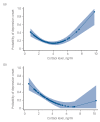Interaction between the BDNF gene Val/66/Met polymorphism and morning cortisol levels as a predictor of depression in adult women
- PMID: 22844024
- PMCID: PMC3461447
- DOI: 10.1192/bjp.bp.111.107037
Interaction between the BDNF gene Val/66/Met polymorphism and morning cortisol levels as a predictor of depression in adult women
Abstract
Background: Common genetic variants, such as the brain-derived neurotrophic factor (BDNF) Val/66/Met polymorphism (rs6265), are known to interact with environmental factors such as early adversity to increase the risk of subsequent major depression. Much less is known about how they interact with individual differences in cortisol, although these also represent a risk for major depression.
Aims: To determine whether this BDNF variant moderated the risk represented by higher levels of morning salivary cortisol in adult women.
Method: We recruited 279 premenopausal women who were at high risk of major depressive disorder because of either negative self-evaluation, unsupportive core relationship or chronic subclinical symptoms of depression or anxiety. Morning salivary cortisol was measured daily for up to 10 days at entry. Participants were followed up for about 12 months by telephone calls at 3-4 monthly intervals. Major depression and severe life events were assessed through interviews at baseline and follow-up; DNA was obtained from the saliva.
Results: There were 53 onsets (19%) of depressive episodes during follow-up. There was a significant U-shaped relationship between adjusted morning cortisol levels at baseline and the probability of depression onset during follow-up. In total, 51% experienced at least one severe life event/difficulty, and this strongly predicted subsequent onsets of depressive episodes. The BDNF Val/66/Met genotype was not directly associated with onsets of depression or with cortisol levels, but there was significant interaction between Val/66/Met and cortisol: the association between baseline cortisol and depression was limited to those with the Val/66/Val variant. There was no interaction between life events and either this BDNF polymorphism or cortisol levels.
Conclusions: Morning salivary cortisol interacts with the BDNF Val/66/Met polymorphism in predicting new depressive episodes. This paper adds to the evidence that single gene polymorphisms interact with endogenous factors to predict depression.
Conflict of interest statement
None.
Figures



Similar articles
-
Polymorphisms in BDNF (Val66Met) and 5-HTTLPR, morning cortisol and subsequent depression in at-risk adolescents.Br J Psychiatry. 2010 Nov;197(5):365-71. doi: 10.1192/bjp.bp.110.077750. Br J Psychiatry. 2010. PMID: 21037213 Free PMC article.
-
BDNF Val66Met polymorphism is associated with higher anticipatory cortisol stress response, anxiety, and alcohol consumption in healthy adults.Psychoneuroendocrinology. 2011 Nov;36(10):1562-9. doi: 10.1016/j.psyneuen.2011.04.010. Epub 2011 May 18. Psychoneuroendocrinology. 2011. PMID: 21596481 Clinical Trial.
-
The BDNF Val66Met polymorphism: relation to familiar risk of affective disorder, BDNF levels and salivary cortisol.Psychoneuroendocrinology. 2009 Oct;34(9):1380-9. doi: 10.1016/j.psyneuen.2009.04.014. Epub 2009 May 26. Psychoneuroendocrinology. 2009. PMID: 19473771
-
The Val66Met brain-derived neurotrophic factor gene variant interacts with early pain exposure to predict cortisol dysregulation in 7-year-old children born very preterm: Implications for cognition.Neuroscience. 2017 Feb 7;342:188-199. doi: 10.1016/j.neuroscience.2015.08.044. Epub 2015 Aug 28. Neuroscience. 2017. PMID: 26318333 Free PMC article. Review.
-
[Posttraumatic stress disorder (PTSD) as a consequence of the interaction between an individual genetic susceptibility, a traumatogenic event and a social context].Encephale. 2012 Oct;38(5):373-80. doi: 10.1016/j.encep.2011.12.003. Epub 2012 Jan 24. Encephale. 2012. PMID: 23062450 Review. French.
Cited by
-
Brain-derived neurotrophic factor and inflammation in depression: Pathogenic partners in crime?World J Psychiatry. 2022 Jan 19;12(1):77-97. doi: 10.5498/wjp.v12.i1.77. eCollection 2022 Jan 19. World J Psychiatry. 2022. PMID: 35111580 Free PMC article. Review.
-
Prospective association of morning salivary cortisol with depressive symptoms in mid-life: a life-course study.PLoS One. 2013 Nov 12;8(11):e77603. doi: 10.1371/journal.pone.0077603. eCollection 2013. PLoS One. 2013. PMID: 24265676 Free PMC article.
-
Cortisol awakening response and subsequent depression: prospective longitudinal study.Br J Psychiatry. 2014 Feb;204(2):137-43. doi: 10.1192/bjp.bp.113.126250. Epub 2013 Dec 5. Br J Psychiatry. 2014. PMID: 24311550 Free PMC article.
-
BDNF rs962369 Is Associated with Major Depressive Disorder.Biomedicines. 2023 Aug 10;11(8):2243. doi: 10.3390/biomedicines11082243. Biomedicines. 2023. PMID: 37626739 Free PMC article.
-
Val66Met BDNF polymorphism as a vulnerability factor for inflammation-associated depressive symptoms in women with breast cancer.J Affect Disord. 2016 Jun;197:43-50. doi: 10.1016/j.jad.2016.02.059. Epub 2016 Mar 2. J Affect Disord. 2016. PMID: 26967918 Free PMC article.
References
-
- Duman RS, Monteggia LM. A neurotrophic model for stress-related mood disorders. Biol Psychiatry 2006; 59: 1116–27 - PubMed
-
- D’Sa C, Duman RS. Antidepressants and neuroplasticity. Bipolar Disord 2002; 4: 183–94 - PubMed
-
- Garcia R. Stress, metaplasticity, and antidepressants. Curr Mol Med 2002; 2: 629–38 - PubMed
-
- De Foubert G, Carney SL, Robinson CS, Destexhe EJ, Tomlinson R, Hicks CA, et al. Fluoxetine-induced change in rat brain expression of brain-derived neurotrophic factor varies depending on length of treatment. Neuroscience 2004; 128: 597–604 - PubMed
Publication types
MeSH terms
Substances
Grants and funding
LinkOut - more resources
Full Text Sources
Miscellaneous

